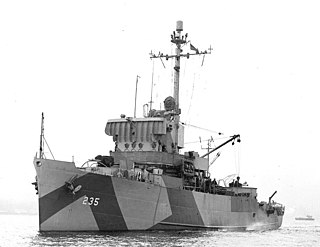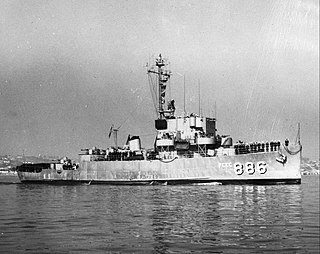USS Execute (AM-232) was an Admirable-class minesweeper built for the United States Navy during World War II. She was originally ordered and laid down as USS PCE-905, the lead ship of the PCE-905 class of patrol craft. She was reclassified as an Admirable-class minesweeper by the time of her June 1944 launch, and named Execute by the time of her November 1944 commissioning. After service in the Pacific during World War II, she was decommissioned in August 1946 and placed in reserve. While she remained in reserve, Execute was reclassified as MSF-232 in February 1955 but never reactivated. In 1962, she was sold to the Mexican Navy and renamed ARM DM-03. In 1994, she was renamed ARM General Juan N. Méndez (C51). She was stricken in July 2001, but her ultimate fate is not reported in secondary sources.

USS Ampere (PCE-919/AM-359/YDG-11/ADG-11) was originally planned as a PCE-905-class patrol craft for the United States Navy, PCE-919, and laid down as an Admirable-class minesweeper, named Drake, for the male duck. Before she was commissioned, her name was cancelled and she was reclassified as a District Degaussing Vessel. She was later renamed Ampere, after the ampere, a unit of electric current, which takes its name from the French physicist André-Marie Ampère.
The third USS Magnet (ADG-9) was a degaussing vessel of the United States Navy, named after the magnet. Originally planned as a patrol craft escort (PCE-879), she was laid down on 27 May 1943 by the Albina Engine & Machine Works of Portland, Oregon; launched 30 September 1943; reclassified YDG-9 on 23 December 1943; and commissioned 10 July 1944.

USS Lodestone (ADG-8) was a degaussing vessel of the United States Navy, named after the mineral lodestone. Originally planned as a patrol craft escort (PCE-876), she was laid down on 27 May 1943 by the Albina Engine & Machine Works of Portland, Oregon; launched 30 September 1943; reclassified YDG-8 on 23 December 1943; and commissioned 10 July 1944.

USS Parris Island (AG-72) was a patrol craft escort named for Parris Island, South Carolina.
USS Dextrous (AM-341) was an Auk-class minesweeper built for the United States Navy which served in World War II, the Korean War, and beyond. She was later transferred to the Republic of Korea Navy where she served as ROKS Koje (PCE-1003).
USS Ptarmigan (AM-376) was an Auk-class minesweeper acquired by the United States Navy for the dangerous task of removing mines from minefields laid in the water to prevent ships from passing. She was the only U.S. Navy ship named for the ptarmigan, a grouse with feathered feet, found in northern regions.

USS Sprig (AM-384) was an Auk-class minesweeper acquired by the United States Navy for the dangerous task of removing mines from minefields laid in the water to prevent ships from passing.
USS Facility (AM-233) was an Admirable-class minesweeper built for the United States Navy during World War II. The ship was ordered and laid down as PCE-905-class patrol craft USS PCE-906 but was renamed and reclassified before her June 1944 launch as Facility (AM-233). After earning three battle stars for service in the Pacific during World War II, she was decommissioned in September 1946 and placed in reserve. While in reserve, Facility was reclassified as MSF-233 in February 1955 but never reactivated. In October 1962, she was sold to the Mexican Navy and renamed ARM DM-04. Her ultimate fate is not reported in secondary sources; she may have been out of service by April 1973 when another member of the Admirable class was acquired by the Mexican Navy and given the name DM-04.
USS Compel (AM-162) was an Admirable-class minesweeper built for the U.S. Navy during World War II. She was built to clear minefields in offshore waters, and served the Navy in the Pacific Ocean. Compel was awarded one battle star for World War II service.
USS Concise (AM-163) was an Admirable-class minesweeper built for the U.S. Navy during World War II. She was built to clear minefields in offshore waters, and served the Navy in the Pacific Ocean.
USS Counsel (AM-165) was an Admirable-class minesweeper built for the U.S. Navy during World War II. She was built to clear minefields in offshore waters, and served the Navy in the Pacific Ocean.

USS Fixity (AM-235) was an Admirable-class minesweeper built for the United States Navy during World War II. The ship was ordered and laid down as PCE-905-class patrol craft USS PCE-908 but was renamed and reclassified before her December 1944 commissioning as Fixity (AM-235). She earned two battle stars in service in the Pacific during the war. She was decommissioned in November 1946 and placed in reserve. In January 1948, she was transferred to the United States Maritime Commission which sold her into merchant service in 1949. Operating as the Commercial Dixie, she sank in the Ohio River in the late 1990s.
USAS Report (AGP-289) was an Admirable-class minesweeper built for the United States Navy during World War II as USS Report (AM-289). Although completed in July 1945, before the end of hostilities, she was placed in reserve and never commissioned into the U.S. Navy. She was reclassified as MSF-289 in February 1955, but remained in reserve until she was struck from the Naval Vessel Register in 1963. She was transferred to the United States Army and served U.S. Army Intelligence from 1963 to 1967 as a motor torpedo boat tender. Report was returned to U.S. Navy custody and loaned to South Korea. As ROKS Kojin (PCE-50) in Republic of Korea Navy service, she served through 1970 and was scrapped in 1973.
USS Creddock (AM-356) was an Admirable-class minesweeper built for the United States Navy during World War II. The ship was ordered and laid down as PCE-905-class patrol craft USS PCE-916 but was renamed and reclassified before her July 1944 launch as Creddock (AM-356). Creddock was launched 22 July 1944 by Willamette Iron and Steel Works, Portland, Oregon; sponsored by Miss N. I. Schmidleys; and commissioned 18 December 1945. Creddock departed Astoria, Oregon, 6 January 1946 and arrived at San Diego, California, 4 days later. There she was placed out of commission in reserve 26 March 1946. Creddock was reclassified MSF-356 on 7 February 1955.
USS Gavia (AM-363) was an Admirable-class minesweeper built for the United States Navy during World War II. The ship was ordered and laid down as PCE-905-class patrol craft USS PCE-907 but was renamed and reclassified before her September 1943 launch as Gavia (AM-363). She earned two battle stars in service in the Pacific during World War II. In May 1946, she was turned over to the Republic of China for service with the Chinese Maritime Customs Service as Yung Chun. She was removed from service in June 1962.

USS Lamar (PCE-899)/USCGC Lamar (WTR-899) was a PCE-842-class patrol craft acquired by the U.S. Navy during World War II for the task of patrolling assigned ocean areas or protecting larger ships in convoy.

Willamette Iron Works was a general foundry and machine business established in 1865 in Portland, Oregon, originally specializing in the manufacture of steamboat boilers and engines. In 1904, the company changed its name to Willamette Iron and Steel Works, under which name it operated continually until its close in 1990.
ROKS Dangpo was a patrol craft of the Republic of Korea Navy (ROKN). Originally built as USS PCE-842, a PCE-842-class patrol craft for the United States Navy during World War II. Dangpo was acquired by South Korea on 13 December 1961 and sunk by North Korean coastal artillery fire on 19 January 1967.

USS Banning (PCE-886) was a PCE-842-class patrol craft for the United States Navy during World War II.







